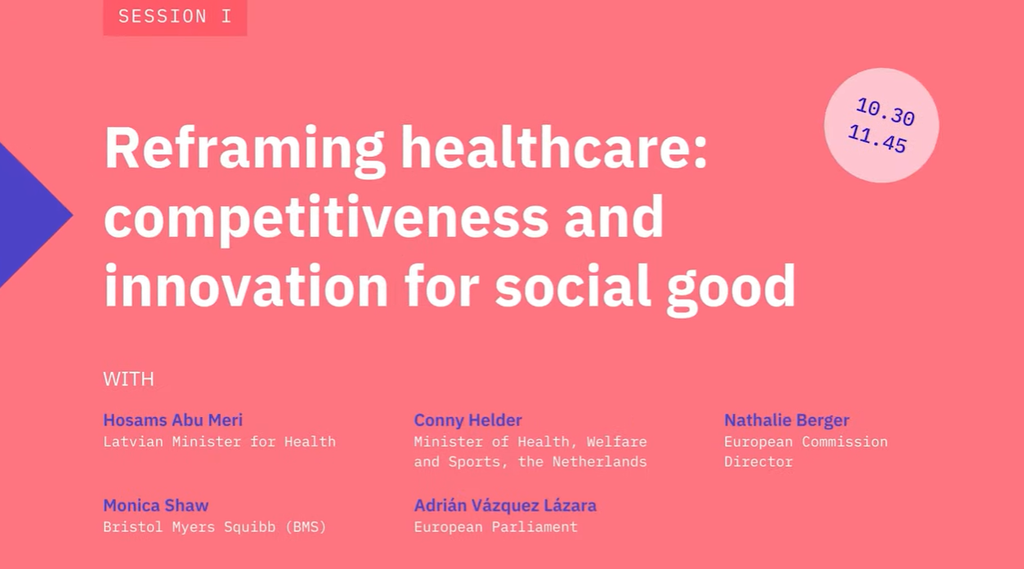Europe's moment: advancing clinical research and health innovation
Next event In person & online

- Area of Expertise
- Sustainable Livelihoods
Sustainable Livelihoods

Director of Patient Advocacy, Corporate Affairs at Bristol Myers Squibb

Associate Director of European Public Policy and EFPIA Liaison at Bristol Myers Squibb

Senior Director of Corporate Affairs, Internal Medicine at Pfizer
Since the start of the COVID-19 pandemic, we’ve begun to not only ask but also embrace difficult questions related to health policy: How can we build resilience against future health crises? Are we investing enough and in the right areas? Are preventative measures keeping our citizens safe? How can we ensure treatment is reaching all who need it?
This unprecedented level of introspection is helping us shape healthcare systems which are more resilient against future health threats, sustainable for future generations and inclusive for all patients. Finding responses to these pressing issues has been a priority for EU institutions and national governments in the past months; however, the solutions have mostly focused on tackling the immediate virus. What about other patients, suffering from chronic conditions, who have seen their lives and treatment completely disrupted in the last year?
This is particularly evident for the cardiovascular disease (CVD) community, including stroke patients, a group which has been disproportionately impacted throughout the crisis. For example, patients with Atrial Fibrillation (AF), a potentially serious heart condition and leading risk factor for stroke, have experienced overall worse health outcomes after contracting COVID-19. “The pandemic worsened the stroke burden, as less people sought timely stroke care, fewer patients were diagnosed and admitted to hospital, and treatment and long-term support [were] delayed. Those at risk of stroke are more likely to have more severe COVID-19 illness and evidence has shown that COVID-19 patients are at higher risk of having a stroke,” highlights Arlene Wilkie, Director General of Stroke Alliance for Europe (SAFE).
The pandemic has also affected treatment pathways of stroke patients, leading to missed opportunities for diagnosis and possible prevention. Referencing a 2020 survey of stroke care providers in Europe, Dr Valeria Caso of the European Stroke Organisation indicated “70% of respondents estimated functional outcomes and recurrence rates of stroke would be affected by the changes in stroke care related to the outbreak”. A study from the UK-based Stroke Association revealed 30% of those who had a stroke during the pandemic delayed seeking emergency medical attention, which attributed to stroke deaths in private homes increasing by 52%. Possible explanations include reduced emergency department visits due to national lockdown measures and patient hesitancy linked to fears of COVID-19 infection or concerns related to overloading the system with a non-COVID-19-related concern.
Immediate investment in stroke prevention could help contain large costs to healthcare systems in the future
The economic impact of stroke, including AF- and other CVD-related stroke, on Europe was already striking prior to the pandemic, making missed diagnoses and subsequent non-treatment all the more alarming in its wake. According to research from SAFE, stroke was estimated to cost 32 European countries €60bn in 2017 alone. Costs included healthcare, social care, informal unpaid care, and lost productivity due to deaths and disability from stroke amongst people of working age. The risk of reoccurrence and treatment of comorbidities, such as depression and venous thromboembolism (VTE), further add to this cost and should not be overlooked.
As a leading cause of death and disability in Europe, it is estimated one in four people will have a stroke during their lifetime, a number set to increase as Europe’s population ages. “We expect the annual number of strokes in the EU to increase by 34%, surpassing 800,000 by 2035. There is an urgent need to address the limitations of current stroke strategies and explore more effective, affordable and widely [applicable] policies to complement existing approaches and ensure the sustainability of healthcare systems,” according to Dr Michael Brainin of the World Stroke Organization (WSO).
However, there is good news.
Reducing the risk factors of stroke is the most cost-effective action for reducing incidence, thereby saving lives and relieving healthcare budgetary strains to some extent. For example, AF-related stroke, a condition which is associated with higher mortality and greater disability than other causes, can in many instances be managed through an appropriate prevention and/or treatment plan. According to Trudie Lobban, Founder of the Atrial Fibrillation Association, targeted investment and programmes for patients at risk for AF-related stroke have been proven as highly effective tools for public health. “We’ve seen that effective policy action is comprehensive: beginning with prevention, building to detection, ensuring protection and finally correction leading to perfecting to ensure the best outcomes for patients.”
A 2020 independent report written by the Economist Intelligence Unit and sponsored by the Bristol Myers Squibb-Pfizer Alliance reviewed approaches to investment in stroke prevention in Europe. Out of the 250 public and private health stakeholders interviewed, 84% of respondents indicated immediate investment in stroke prevention could help contain large costs to healthcare systems in the future.
Healthcare should be resilient to aid and protect all types of patients
We can also reduce the burden of disease if we harness some of the newer tools in our repertoire: advances in technology. We’ve experienced a digital health revolution which has brought forward positive changes for accessible and cost-effective patient solutions, including tele-health consultations and digital tools which inform about risk factors, promote the detection of acute stroke symptoms, and allow users to conduct self-guided assessments.
However, these solutions can only be truly effective if they are accessible to all European citizens, regardless of age or socio-economic demographics. Andrea Vassalotti of the World Heart Federation (WHF) notes: “digital technologies including apps, wearable devices, and diagnostic equipment can strengthen efforts to alleviate the health burden of heart-related stroke. The development of the WHF World Heart Observatory is one example of an online resource to capture global research, tools and initiatives in cardiovascular health, ultimately informing medical care and shaping health policy.”
As we rebuild our systems, let’s not forget healthcare should be resilient to aid and protect all types of patients, including those suffering from a virus, living with a chronic disease or experiencing a medical emergency. COVID-19 has brought to light the high vulnerability of patients with chronic conditions, including AF- and other CVD-related stroke. We can clearly see that reducing the burden these conditions present to society may help make our healthcare systems more resilient against future health threats and to ensure our citizens can live longer and healthier lives.
We have seen how health crises know no borders, and the need for an EU-level strategy on CVDs is more critical than ever to complement national policies and promote best practice, including on access to stroke prevention and care. Birgit Beger, CEO of the European Heart Network (EHN), highlights that the burden of CVD remains greater than any other disease in the EU. “We need innovative solutions to ensure access to prevention and treatment of CVD across Europe. EHN’s CVD action plan calls for targeted action to reduce premature disease and death from CVD and inequalities in cardiovascular death rates in the EU.”
Targeted actions and investment in life-saving prevention and treatment can tackle health crises, including chronic conditions. If we invest in prevention of AF- and other CVD-related stroke, we can strengthen the future stability of our healthcare systems.
Next event In person & online

Past event In person & livestreamed

Past event In person

Past event In person & livestreamed





Stay informed
We use cookies and similar technologies to adjust your preferences, analyze traffic and measure the effectiveness of our campaigns. Learn more about our privacy policy.